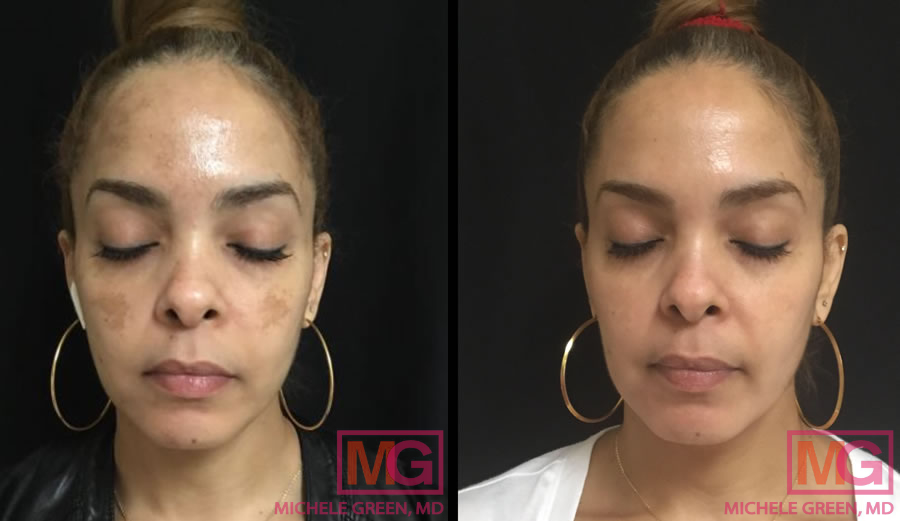Post Laser Hyperpigmentation
Melasma, also known as facial hyperpigmentation, causes brown or tan patches on the face, due to an overproduction of melanin. There are a number of triggers to melasma including pregnancy, birth control pills, and sun exposure. Melanin is the primary determinant of skin pigmentation and hair color, and if you produce too much melanin in any area of your body, the result is hyperpigmentation, a brown spot, or discoloration on your skin. Dr. Michele Green is an expert in the treatment of melasma as well as disorders of hyperpigmentation on the face and body. As a leader in cosmetic dermatology, she is an expert in treating pigmentation with chemical peels, Cosmelan, Mesopeels, and laser treatments.
Hyperpigmentation, as well as melasma, can be exacerbated by treating the skin with the wrong laser therapy, or a laser that is not correct for your particular skin type. Dr. Michele Green specializes in treating these cases of hyperpigmentation as a consequence of laser therapy. In some cases, pigmentation can occur after laser resurfacing with Fraxel laser, IPL, Picosure, Halo laser, ablative lasers, laser hair removal, or other laser treatments. This side effect, known as post-laser hyperpigmentation or post-inflammatory pigmentation (PIH) consists of dark patches or lesions, which can take a year or longer to resolve on their own, or be permanent without the proper treatment. Patients who have darker skin tones are at an increased risk for this condition, so special care must be taken when choosing laser treatments. Unfortunately, poor patient selection and laser choice can often cause this unwanted side effect from laser treatment.
Post-inflammatory hyperpigmentation (PIH) can be caused by injury to the skin as a result of sunburn, surgery, laser treatment, or other cosmetic procedure. If you are suffering from post-inflammatory hyperpigmentation from a laser treatment, Dr. Green is here to help you. With over 25 years of experience in treating melasma and disorders of pigmentation, in her boutique NYC office, she will help remedy your facial or body discoloration. From the best skin care, skin lightening and brightening, bleaching, chemical peels, and non-ablative treatments, Dr. Green is a world-renowned, board-certified dermatologist, in New York. She is an expert in treating conditions involving pigmentation and post-inflammatory hyperpigmentation.
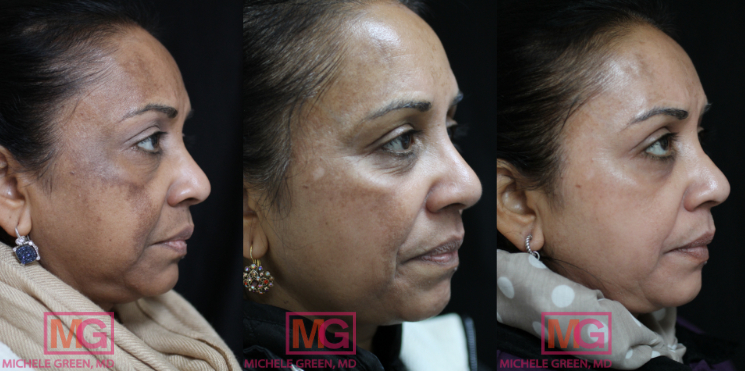
55-64 year old woman treated with Cosmelan
What is post-inflammatory hyperpigmentation?
Post-inflammatory hyperpigmentation (PIH) is a temporary, or permanent, pigmentation that follows an injury to the skin. PIH is most common in patients with darker skin tones, whose skin is more sensitive to this type of injury. Post-inflammatory hyperpigmentation can be the result of inflammatory acne, eczema, various dermatoses, or after laser treatment. Even some medications, such as antimalarial drugs, can cause post-inflammatory pigmentation of the skin.
When the skin gets damaged, the inflammation in the epidermis stimulates the melanocytes to increase melanin production and transfer the pigment to the surrounding keratinocytes. The dermal layer of the skin can be injured as well and the melanin becomes trapped in this basal layer and appears discolored. The areas of the skin which are inflamed heal with patches that are light brown to almost black in color. Exposure to ultraviolet light (UV light) worsens this inflammation, as well as laser treatment. For this reason, strict sun protection of the inflamed or hyperpigmented areas is crucial to allowing the skin to heal, as well as constant reapplication of sunscreen with an SPF 50 or higher.
Can laser treat hyperpigmentation?
There are many different forms of hyperpigmentation, and the type of cosmetic procedure that is most appropriate for treating hyperpigmentation depends on the way that the condition presents, as well as the skin tone of the patient. Patients who are interested in reducing the appearance of age spots and sun damage may benefit from having laser treatment. Melasma is a condition characterized by brown or grey-brown patches of skin that are darker in color than the rest of the surrounding skin. Post-inflammatory hyperpigmentation refers to the dark spots that are left behind following an inflammatory skin condition such as an acne breakout, rash, or injury. Dr. Green does not recommend treating melasma or post-inflammatory hyperpigmentation with lasers.
The hyperpigmentation associated with melasma and post-inflammatory hyperpigmentation may be worsened by laser treatment, as the heat and energy can cause the pigment itself to become further entrenched in the skin. Some forms of hyperpigmentation respond well to laser treatment, while treating certain kinds of hyperpigmentation with lasers can make it even more difficult to remove later on. For this reason, it is imperative that patients seek treatment for their hyperpigmentation from a board-certified cosmetic dermatologist with the expertise and experience to recommend the treatments most appropriate for them. Dr. Michele Green in NYC is an internationally renowned dermatologist with over 25 years of experience providing patients from around the world with the best non-invasive solutions for their hyperpigmentation. In her private dermatology office located in the Upper East Side neighborhood of Manhattan, she offers a host of treatments for hyperpigmentation including chemical peels, specially formulated skin lightening products, and laser treatments.
Fraxel Dual laser is often referred to as the “magic eraser” for its unique ability to target a myriad of skin conditions. Fraxel is an excellent treatment option for patients with Fitzpatrick skin types I-III who are looking to reduce the appearance of hyperpigmentation associated with sun spots, age spots, freckles, and an uneven skin tone or texture. Fraxel employs a fractionated laser technology to create micro-injuries in the skin to induce the natural wound healing process of the skin, which stimulates the production of new collagen and healthy skin cells. In addition to hyperpigmentation, Fraxel can be used to effectively treat acne scars, fine lines and wrinkles, and stretch marks. Fraxel should not, however, be used to treat melasma or post-inflammatory hyperpigmentation. Patients who have darker skin types should not be treated with Fraxel as it can cause unwanted side effects.
AlexTrivantage laser is an Nd:YAG laser used to target distinct sun spots and pigmented lesions. AlexTrivantage emits wavelengths of light that are absorbed by the excess pigment in the skin. The light energy is then converted into heat, which eliminates the hyperpigmentation and simultaneously stimulates the production of new, healthy skin cells. This laser treatment can also be used for tattoo removal. AlexTrivantage is a great laser treatment option for targeting individual sunspots and pigmented lesions, leaving the surrounding skin unaffected.
Clear + Brilliant laser is a gentle resurfacing laser that is commonly referred to as a “mini Fraxel.” Clear + Brilliant creates microscopic treatment zones to stimulate collagen production, remove dead skin cells, and produce new, healthy skin. In addition to treating hyperpigmentation associated with sun damage and sunspots, Clear + Brilliant can reduce the appearance of fine lines and enlarged pores. For patients of all skin tones, Clear + Brilliant is a safe and effective laser treatment for improving overall skin tone and texture without any downtime whatsoever.
Topical Therapies for Post-Inflammatory Hyperpigmentation post laser
There are many different topical creams that can be used to lighten post-inflammatory hyperpigmentation and improve the appearance of the skin. The following topical treatments can be used in combination to brighten this pigmentation both in the dermis and epidermis of the skin:
- Vitamin C
- Cosmelan
- Mesopeels
- Hydroquinone
- Tranexamic Acid
- Azelaic Acid
- Arbutin
- Tretinoin
- Kojic acid
- Glycolic acid peels
- Steroid creams
- Licorice extracts
- Niacinamide
- Lactic Acid
- Salicylic Acid
- Mandolin acid
- Retinoids
- SkinMedical Lytera Skin Brightening Complex
- Tri-Luma (Prescription of fluocinolone acetone 0.01%, Hydroquinone 4%, tretinoin 0.05%)
- Elure Advanced Brightening Night Cream and lotion (contains Ligninase)
- Coffeeberry
- Extracts of orchid, grape seed, Aloe vera, marine algae, or green tea
Woman treated with Cosmelan – 10 weeks
Who is most susceptible to post-laser hyperpigmentation and PIH?
Patients with darker skin types are the most susceptible to the effects of laser treatment. In particular, Asian patients, Hispanic patients, and African American patients who have Fitzpatrick skin types III or greater. While fractional lasers or fractional CO2 lasers are considered safe for patients with lighter skin tones, patients with darker skin tones are at an increased risk of having erythema and pigmented areas with resulting post-inflammatory hyperpigmentation. The darker your skin tone, the more difficult it can be to lighten this epidermal melanosis.
Can laser cause hyperpigmentation?
Unfortunately, hyperpigmentation can be an adverse side effect of having laser treatment. The risk of developing hyperpigmentation after laser therapy is significantly higher when patients are treated by inexperienced providers or in a setting such as a medical spa. In order to avoid post-inflammatory hyperpigmentation and other negative side effects, it is recommended to always seek laser treatment from an experienced board-certified dermatologist, like Dr. Michele Green in NYC. Post-laser hyperpigmentation may occur due to inflammation of the skin caused by the laser device, especially when inappropriate laser settings or laser type are selected for treating a patient. When the epidermis of the treated area is inflamed, melanocytes (the skin cells responsible for pigment) are stimulated to increase melanin production. Exposure to UV radiation after laser treatments can also lead to or worsen hyperpigmentation.
Does laser hair removal cause hyperpigmentation?
Choosing the correct hair removal laser is essential not only to have the best cosmetic results but also to avoid unwanted side effects, such as post-inflammatory hyperpigmentation (PIH). If you have a darker skin tone, such as Latina, Asian, or African American skin, special care must to used in selecting the correct laser and settings used for laser procedures, including laser hair removal. The Candela Gentle Yag Pro Laser is specially designed for patients with darker skin types who are most susceptible to post-inflammatory hyperpigmentation.
When choosing to have laser hair removal, it is crucial to select a clinician who understands your skin type and the correct laser treatment to prevent any unwanted side effects, such as PIH. Unfortunately, in many states, laser treatments are not under regulations, and there are many spas and clinics which have untrained and unauthorized assistants doing laser hair removal. It is important to do your research and google the best lasers and treatments for your skin type before proceeding with any cosmetic treatment.
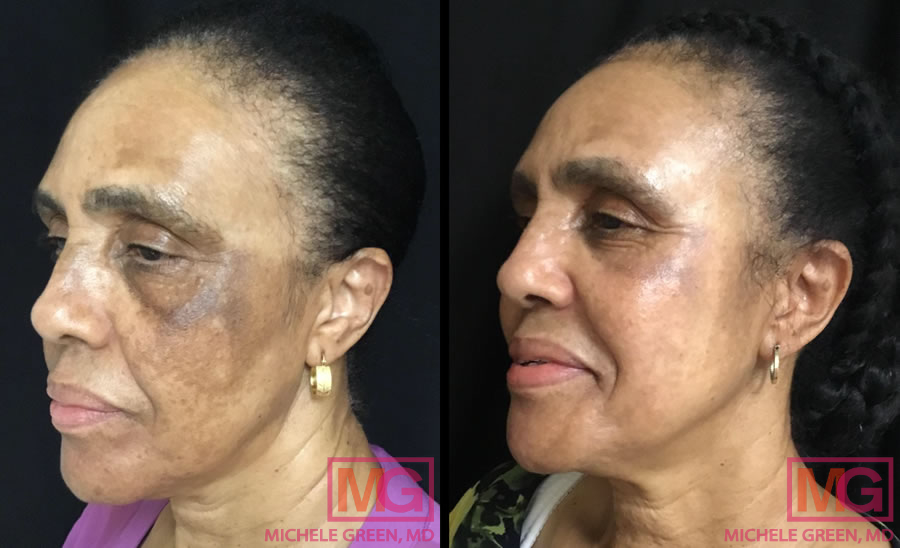
Woman treated with Cosmelan – 12 months
Can IPL cause hyperpigmentation?
Depending on the settings of the laser, the skin tone and type of the patient, and the form of hyperpigmentation that is being targeted, treatment with IPL (which stands for intense pulsed light) can potentially cause post-inflammatory hyperpigmentation or worsen existing hyperpigmentation such as melasma. A clinical study by Fang et al. showed that 20 out of 675 patients with skin types III-IV who were treated with IPL showed melasma-like hyperpigmentation within three months following IPL treatment. If IPL is used to treat hyperpigmentation, it is common to experience an initial darkening of the brown pigment already present in the treated areas for up to two weeks. With time, the brown spots flake off the skin to reveal healthy skin with a more even skin tone.
Can Fraxel laser cause hyperpigmentation?
When you consult with an experienced board-certified cosmetic dermatologist, like Dr. Michele Green in NYC, the result of Fraxel treatment is a smoother, brighter complexion that is more even in texture and tone. It is important that a medical professional evaluate your skin and determine as to whether or not you are a good candidate for the procedure. A good candidate for treatment with Fraxel is an individual with Fitzpatrick skin type I-III who would like to reduce the appearance of hyperpigmentation associated with aging or sun damage, fine lines, acne scars, surgical scars, and even stretch marks. Using Fraxel to treat patients with darker skin tones can result in unwanted side effects, including exacerbation of hyperpigmentation, as a result of the laser interacting with skin pigment.
Patients with melasma should not be treated with the Fraxel laser, as the treatment can worsen existing hyperpigmentation. Any patient that is being treated with Fraxel should strictly avoid sun exposure because UV radiation can cause or worsen hyperpigmentation. For patients with dark skin or for those who would like to address melasma, there are a number of non-invasive cosmetic treatment options that are more ideal than Fraxel. Cosmelan and other types of chemical peels are some examples of preferred methods for treating hyperpigmentation on patients with darker skin tones. When you consult with expert cosmetic dermatologist Dr. Green, she will assess your skin and collect a thorough medical history to determine what treatment options are best suited for your skin and aesthetic goals.
What is the best treatment for Post Inflammatory Hyperpigmentation (PIH)following laser
The best treatment for PIH depends on both your skin type and the area of skin affected by the laser treatment. Again, laser treatment is not the best way to treat PIH. Topical skin lightening creams and sunblocks are the first-line treatment for PIH. Unfortunately, when numerous laser treatments have been performed, the post-inflammatory hyperpigmentation can be severe, and cosmetic treatments such as chemical peels are indicated.
One of the best treatments for resolving PIH after laser treatment is Cosmelan. Cosmelan is uniquely able to treat PIH on the face and chest as a result of laser treatment and other discoloration. For more sensitive areas, such as the axillae and groin, Mesopeels combined with hydroquinone-free skin care is very effective at treating these areas of hyperpigmentation. When the undereye area is involved, Mesopeel Periocular peels are specifically formulated for the delicate skin around the eyes and for treating dark circles.
How to get rid of post laser hyperpigmentation
Depending on the area of the body which is hyperpigmented by laser treatment, there are a number of different skin lightening creams and modalities used to treat hyperpigmentation after laser. First-line treatment is with skin lightening creams and sun avoidance. Depending on the area of skin involved, hydroquinone-based products may be best to use to have the quickest response. Unfortunately, there are areas of the body that are too sensitive to hydroquinone, and a skin-lightening cream that contains tranexamic acid or other non-hydroquinone-based products should be used. Dr. Green does not advise treating PIH or post-laser hyperpigmentation with lasers such as Fraxel or intense pulsed light (IPL).
Dr. Green offers hydroquinone, retinoid, and hydroquinone-free products for skin lightening in different areas of the body. Areas such as the axillae, inner thighs, and bikini area are more sensitive to hydroquinones and require different creams and different methods of skin lightening. Dr. Green is an internationally renowned expert in skin lightening, chemical peels, Cosmelan, and laser skin treatments, and with her MGSKINLABs unique line of products will help customize the best treatment for you.
How to treat hyperpigmentation after laser hair removal
Hyperpigmentation after laser hair removal may be caused by your skin reacting to the laser energy or heat. Most of the time, hyperpigmentation after laser hair removal is temporary and will resolve on its own. Typically, it lasts one to two months post-treatment. However, if the hyperpigmentation is persistent or you are unable to wait for the pigmentation to resolve due to time constraints, hydroquinone-based products can be used to quickly lighten the pigmented areas. For more sensitive areas like the underarms, bikini, and inner thighs, hydroquinone-free skin lightening products like tranexamic acid may be recommended to prevent skin irritation that can worsen hyperpigmentation. The best way to determine how to treat hyperpigmentation caused by laser hair removal treatment is by consulting with a board-certified medical professional with the expertise and experience to recommend the products and treatments most suitable for your situation. Dr. Green in NYC is an internationally renowned cosmetic dermatologist who is consistently voted as one of New York’s best physicians by Castle Connolly, Super Doctors, and New York Magazine. Dr. Green will customize your treatment protocol so that it is best suited to your skin concerns and aesthetic goals.
Chemical peels for PIH
One of the classic methods for removing post-inflammatory hyperpigmentation from lasers is chemical peels. There are a variety of types and strengths of chemical peels, from trichloroacetic (TCA) acid, salicylic acid, to glycolic acid, to treat PIH. Strong chemical peels cannot be used when treating PIH since this will induce too much inflammation and can result in an increase in hyperpigmentation.
Vi Peels are another form of chemical peel, which can treat pigmentation, pores, scarring, and PIH. Vi Peels are a combination of TCA, retinoid acid, salicylic, acid, and phenol. Vi Peels do not induce the same inflammation as high-strength peels induce. These peels can be used in conjunction with hydroquinones, kojic acid, and hydrocortisone, to increase the improvement of the PIH.
Cosmelan, Mesopeels, and Dermamelan are excellent types of chemical peels, which can be used to treat post-laser hyperpigmentation in various areas of the body. Cosmelan is ideal for treating facial pigmentation, especially when melasma is worsened by laser treatment. Mesopeels can be used on the more delicate areas of the body, such as the axillae and groin, and Dermamelan Intimate for discoloration and PIH in the groin and vaginal area. Depending on the area of the body affected by PIH, there are unique treatments to ameliorate each of these special areas.
Cosmelan peels for treatment of post laser hyperpigmentation
Cosmelan is a two-part system of chemical peels to treat melasma, discoloration, PIH, and hyperpigmentation of the face. Depending on both the degree of sun damage and your skin type, the Cosmelan MD peel is left on the skin for 4 to 10 hours. Cosmelan peels consist of a compound of 8% hydroquinone, Retin-A, and 51 active ingredients to lighten the skin. The main Tyrosinase inhibitors which lighten the skin in Cosmelan include Kocic Acid, Azelaic Acid, Arbutine, Phytic Acid, Licorice, and Ascorbic Acid.
Cosmelan peels are used in conjunction with a specific at-home treatment protocol that patients need to follow to augment the in-office Cosmelan peel. The protocol consists of using Cosmelan 2 as directed each day and avoiding all sun with daily use of a high SPF sunscreen. After 3 weeks of using the home products as directed, the patient returns to the office for the second Cosmelan peel. This second peel is followed by continued use of the at-home creams and a close follow-up by Dr. Green after the topical creams are completed.
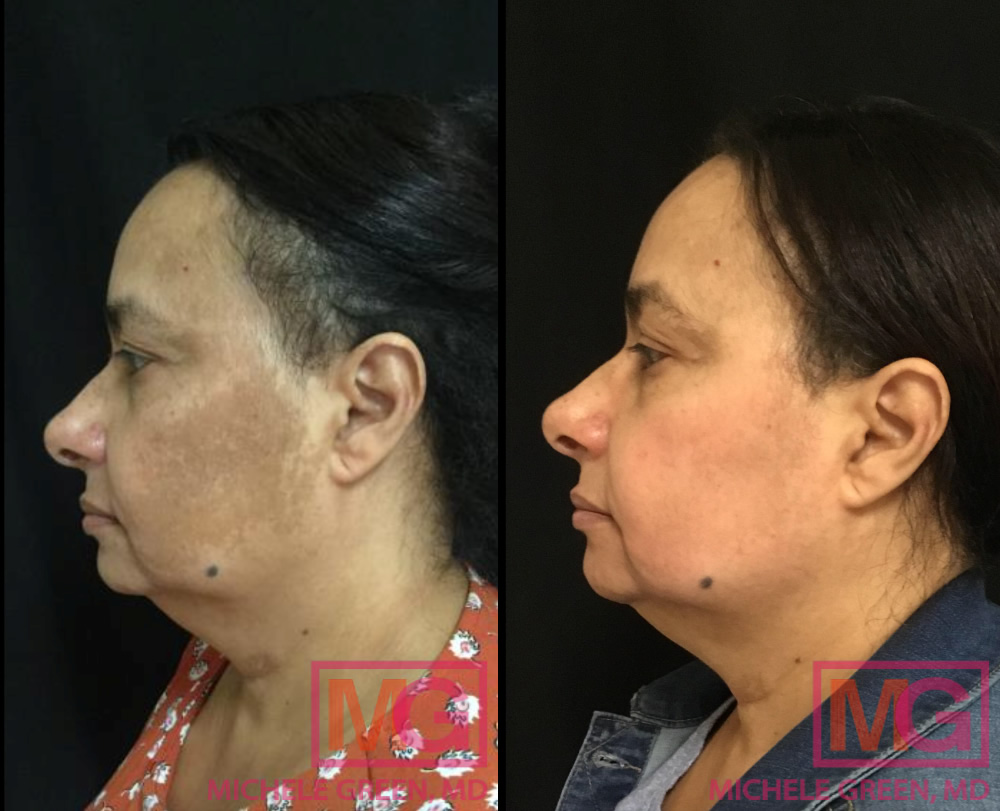
Cosmelan treatment for melasma
Mesopeels Periocular for Post Inflammatory Hyperpigmentation around the eyes
There are cases of post-inflammatory hyperpigmentation around the eyes and dark circles, which are difficult to treat. Mesopeel Periocular are specially designed to treat discoloration and hyperpigmentation around the eye area. A series of peels are performed two weeks apart until the pigmentation resolves. Typically six Mesopeels are indicated.
Is Post-Inflammatory Hyperpigmentation (PIH) after laser permanent?
In general, PIH is a treatable cosmetic problem that requires time and patience with topical treatment and strict sun avoidance. However, there are many cases that require chemical peels, Cosmelan peels, and strong skin lightening agents to bring the color of patients with darker skin back to normal. Unfortunately, there are times when the damage is so severe from the laser, either with hyperpigmentation or hypopigmentation, that the results are permanent.
How to avoid hyperpigmentation after laser
Limiting sun exposure is one of the most important advisements for patients who are struggling with hyperpigmentation, as well as for those who are undergoing laser treatments. Melanocytes are the skin cells that are responsible for producing melanin, the component of skin associated with pigment. Melanocytes have memory and are triggered by UV light to create melanin. In order to prevent hyperpigmentation from worsening or returning after having treatment, patients need to protect their skin from sun exposure. It is recommended to adhere to strict sun avoidance, and wearing a sun hat or protective clothing is advised. Using a broad-spectrum sunscreen with a minimum SPF 30 is essential. Dr. Green advises first applying a chemical sunscreen and then layering a physical sunscreen on top for best coverage. Patients should reapply sunscreen every 90 minutes and avoid being out when the sun is at its peak, typically between 10 AM and 2 PM.
Additionally, many laser treatments can cause skin to become photosensitive afterwards. Increased photosensitivity makes skin more susceptible to UV damage and various kinds of irritation. Any sun or UV exposure following laser resurfacing treatments can damage the skin and potentially negatively impact the results of treatment, as well as increase the risk of developing unwanted side effects. To prevent any unwanted side effects like post-inflammatory hyperpigmentation, it is best to have your consultation and laser treatments with an experienced board-certified cosmetic dermatologist, like Dr. Michele Green in New York City. Be cautious of medical spas and salons where, often, inexperienced and unqualified staff are performing laser treatments on patients.
Those with a recent history of sun exposure, such as after sun bathing, should delay their laser treatment until the tan has completely faded. Always follow the pre- and post-treatment instructions provided by Dr. Green carefully to prevent any adverse reactions or unwanted side effects. Most importantly, avoid the sun and practice adequate sun protection.
What is the Best Laser for Post Inflammatory Hyperpigmentation (PIH)?
Laser treatments are not the best method for treating post-inflammatory hyperpigmentation. Although there have been reports, such as those from the J of Am Acad Dermatology and the Journal of Eur Acad Dermatol Venereol describing treatment with low-fluence 1064-nm Q-switched nd:YAG laser, Erbium laser, and Fraxel laser, it is best not to attempt treatment with these lasers. Even Dermatol Surg Journal describes the treatment of PIH with fractional photothermolysis as well as the Am J Clin Dermatology describes improvement after the low-dose Q-switched neodymium-doped yttrium aluminum garnet laser treatment. Since most post-laser hyperpigmentation was caused by too much energy to the skin, applying more heat through laser energy may not be the best treatment option for reducing PIH. There are many patients who have PIH from frequent Fraxel laser treatments, IPL, Picosure, or Halo laser treatments, and continuing to do more treatments with these lasers is not the best option. Healing this PIH generally involves topical therapy with some form of chemical peeling to create new collagen in your skin.
Sunscreen and post-laser hyperpigmentation
Photoprotection is crucial in the successful management of post-laser hyperpigmentation, PIH, and especially melasma. Both UVB and UVA rays can stimulate melanin production by melanocytes, which is why it is important to seek broad-spectrum sunscreens for adequate protection. UVB is the largest erythemogenic, causing the most pigmentation, while UVA can also lead to increased cases of chronic pigmentation. Dr. Green recommends using both a physical sunblock along with a chemical sunblock, to completely protect your skin from both UVA and UVB rays.
A sunscreen with a physical block would include one with zinc oxide or titanium dioxide. Chemical sunblocks with avobenzone, oxybenzone, or octocrylene, can provide increased broad-spectrum protection from both UV rays, and protect against the visible spectrum. Tinted sunscreens, such as those with iron oxide, may produce added photoprotection benefits. In addition to sunscreen, sun avoidance, broad-rimmed hats, sun protective clothing, and sunglasses, all help to protect your skin from the sun.
Can hyperpigmentation be removed?
Yes! In her private dermatology office located in the Upper East Side neighborhood of Manhattan, Dr. Green offers a host of non-invasive cosmetic treatments that are designed to effectively and safely remove various types of hyperpigmentation. The treatment that is best suited to you will depend on the type of hyperpigmentation that you have. For example, Cosmelan is a revolutionary type of chemical peel treatment that is very effective against melasma and post-inflammatory hyperpigmentation on patients of all skin types and tones. Cosmelan contains 51 active ingredients including tyrosinase inhibitors that block the production of melanin (kojic acid, azelaic acid, ascorbic acid, phytic acid, arbutin, licorice). Cosmelan is a permanent solution to lightening the appearance of hyperpigmentation associated with melasma and PIH, as long as strict sun avoidance is maintained after the treatment.
Chemical peels can treat various skin concerns including hyperpigmentation, sun spots, discoloration, sun damage, fine lines and wrinkles, acne, and acne scars. Chemical peels work as a skin resurfacing treatment that uses a chemical solution to remove the outer layers of dead skin to reveal healthy new skin that is more even in tone. There are numerous kinds of chemical peels such as AHAs, glycolic acid, trichloroacetic acid (TCA), VI Peel, and Mesopeels. Consult with an experienced dermatologist like Dr. Green to navigate through the best and safest treatment options for your hyperpigmentation.
To remove unwanted sunspots and age spots, Fraxel, Clear + Brilliant, and AlexTrivantage lasers can be used. Fraxel is a fractionated skin resurfacing laser that creates micro-injuries on the skin to stimulate new collagen formation and healthy new skin cells. However, Fraxel is suited for lighter skin tones, such as skin types I-III. For darker skin tones, Clear + Brilliant laser is a great option, also known as “mini-Fraxel.” The mechanism of Clear + Brilliant is similar to that of Fraxel, except it is very gentle on the skin with zero downtime. AlexTrivantage laser is a nd:YAG laser that specifically targets the pigment in dark spots without affecting the surrounding skin. Regardless of the type of hyperpigmentation that you are looking to address, whether it is related to sun damage, aging, melasma, or a post-inflammatory condition, Dr. Green can help.
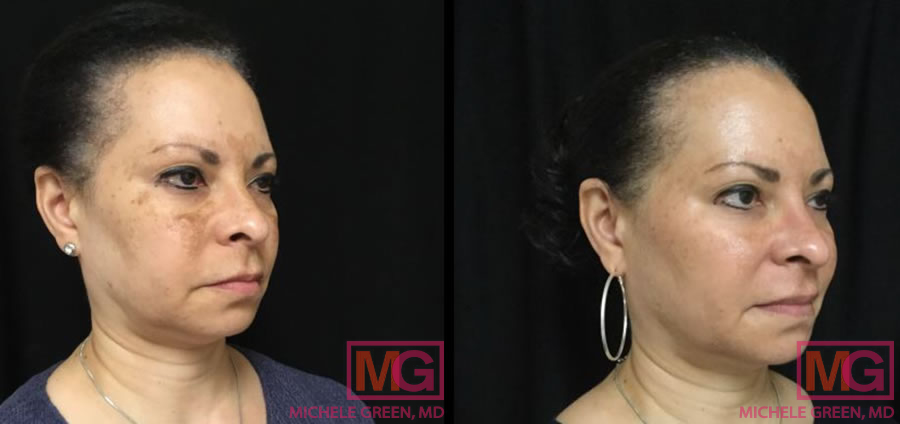
Can laser treatments remove hyperpigmentation permanently?
Having your laser treatments with an experienced medical professional can be an effective solution for permanently reducing the appearance of various types of hyperpigmentation. It is important to be selective when choosing the provider who will perform your laser treatment in order to prevent unwanted side effects and guarantee satisfactory cosmetic results. A board-certified dermatologist, such as Dr. Michele Green in NYC, will have the experience and expertise required to recommend the safe, effective, and appropriate treatments for your hyperpigmentation. For example, Fraxel and AlexTrivantage are revolutionary lasers that permanently remove sun spots, age spots, and sun damage. However, if the hyperpigmentation is due to melasma or a previous laser treatment, lasers are not the ideal treatment option. For addressing these skin concerns, Cosmelan may be a better option.
Although laser treatment can permanently remove certain types of unwanted hyperpigmentation, like sun spots and age spots, it will not prevent skin discoloration from developing in the future. If the skin becomes damaged from sun exposure or acne, new spots or patches of hyperpigmentation will form and will require additional treatments. For this reason, Dr. Green always recommends that patients with a history of hyperpigmentation adhere to strict sun avoidance and proper sunscreen application. Layering a chemical sunscreen and physical sunscreen, reapplying sunscreen, wearing a hat, and covering with protective clothing or parasol are all recommended. When you consult with Dr. Green regarding your hyperpigmentation, you will have the opportunity to learn more about how to best prevent your hyperpigmentation from worsening or returning after treatment.
How much is laser treatment for hyperpigmentation?
The cost for treating hyperpigmentation with laser varies depending on a number of contributing factors. The experience level of the provider performing your laser treatments, the type and number of laser treatments integrated into your plan, and the geographic location of the office in which you are treated are some of the factors that will impact the total cost of your treatment. For example, having your laser treatment at a medical spa or with an aesthetician is often more inexpensive than with an experienced board-certified dermatologist, although there is a much greater risk of developing unwanted side effects such as exacerbation of hyperpigmentation or even scarring. For this reason, it is always recommended to have your laser treatments with a board-certified medical professional, such as Dr. Green in NYC.
How do I get started with treating my post-laser hyperpigmentation today?
Experiencing post-laser hyperpigmentation can be devastating for patients, particularly when the expectation for the initial laser procedure was to achieve a more even skin tone and reduce hyperpigmentation. Many patients that struggle with hyperpigmentation express that it is a source of great frustration and negatively impacts their self-esteem, which can be especially true for individuals presenting with hyperpigmentation after having a laser treatment. If you are looking for a non-invasive solution to an uneven skin tone, Dr. Michele Green in New York City can help. Whether your unwanted hyperpigmentation is associated with aging, sun damage, melasma, or an unwanted side effect from having a laser treatment, Dr. Green can help to greatly restore your even-toned complexion and self-confidence.
Dr. Green is a board-certified cosmetic dermatologist and internationally recognized expert when it comes to treating various forms of hyperpigmentation, including post-inflammatory hyperpigmentation and discoloration resulting from laser therapy. Dr. Green has over two and a half decades of experience providing some of the most discerning men and women from around the world with the best non-invasive cosmetic treatments for facial rejuvenation including laser resurfacing, dermal fillers, Botox, microneedling, and chemical peels like Cosmelan and Mesopeel. She is consistently voted one of New York’s best dermatologists by Castle Connolly, New York Magazine, and Super Doctors. When you consult with Dr. Green at her private dermatology office in Manhattan, you’ll have the opportunity to discuss in-depth your specific skin concerns and aesthetic goals. Dr. Green will then work with you to customize a treatment plan that is best suited to your situation and delivers ideal, long-lasting results. To learn more about the best treatment options for different forms of hyperpigmentation and get started with your personalized treatment plan with Dr. Green, call the NYC-based office at 212-535-3088 or contact us online today.
 212-535-3088
212-535-3088 